Pehr Frigel’s Om Contrapunkten (c. 1815)
The Earliest Extant Counterpoint Method in the Swedish Vernacular, Edited and Translated with Historico-Critical Commentary
Mattias Lundberg
[1] Introduction
The systematic and comparative study of counterpoint and composition treatises, including a critical examination of their intertextual relationships and interpretational histories, has long been acknowledged as a key to understanding compositional and improvisational processes during the so-called ‘common practice’ period.[1] The central texts within the tradition of species counterpoint instruction, emanating from the model of Fux’s Gradus ad Parnassum (albeit ultimately from Diruta et al.) and continued by Albrechtsberger, Cherubini and others, have recently received much attention, especially in the study of the compositional processes of individual composers.[2] However, their place in the context of nineteenth-century compositional instruction writ large – a phenomenon closely linked to the nascent European conservatoires – has not been systematically studied. An important prerequisite for such research is the critical editing and analysis of the many nineteenth-century adaptations of species counterpoint, taking into account their relations to competing instructional models such as those advocated by Friedrich Erhard Niedt and the predominantly Italian partimento instruction.[3]
The notion of Om Contrapunkten being the earliest extant counterpoint method in the Swedish vernacular, as proposed in the title of this study, is not a particularly audacious one. In fact it is highly unlikely that any predecessor in this category will ever be identified, given the particular regional and historical circumstances in which Frigel’s treatise fits.[4] It provides some of the earliest written instances of vernacular vocabulary for technical terms previously expressed only in Latin, Italian or German, which have since entered into the mainstream of Swedish musical discourse and been of great significance in music theory. It also offers, by way of interpretational glosses, valuable insight into the dissemination and interpretation of sources and ideas from a number of different music-theoretical traditions. It is an important document in the history of theoretical and compositional training in Sweden, and thus also offers a key to understanding Swedish music of the later nineteenth century. Moreover, Om Contrapunkten situates the history of contrapuntal instruction in Sweden in its international context, and its edition and translation here facilitate its entry into the ongoing comparative study of the music-theoretical texts elsewhere in Europe, and make it accessible to a non-Swedish readership.[5]
[2] The author of the treatise and his musical and scholarly background
Pehr Frigel was without a doubt the most administratively powerful individual in Swedish musical life during the first half of the nineteenth century, a period depicted by some historiographers as one of decline in Swedish music history. In 1796, by way of an extensive and detailed pro memoria, he spearheaded the return of music-theoretical instruction to the Swedish Royal Academy of Music (founded in 1771). His efforts were largely successful, even in the face of considerable obstacles, namely serious financial hardship, a shortage of experienced and competent instructors, as well as a rather limited stock of student candidates, and such instruction was cultivated in different forms throughout his long period as Secretary of the Academy.[6] He was of the firm opinion that the study of music theory should initially be confined to meticulous drilling in the fundamental and immutable rules of harmony and counterpoint, in order that those who really possessed the potential of becoming composers might become self-sufficient in music theory.[7] His complaints at the general reluctance and disinterest of Swedish musicians and composers with respect to acquiring a more solid and thorough education in music theory were to resurface in the second half of the nineteenth century, albeit then in the form of criticism aimed at the very type of Academy organization that Frigel had been so instrumental in shaping.[8]
Pehr, or Petrus, Frigelius was born in Kalmar in southeastern Sweden in 1750, where his father Petrus Frigelius the Elder, a doctor of theology and mathematician, was a lecturer at the gymnasium. The family later moved to the nearby parish of Madesjö. Petrus Frigelius the Younger and his older brothers were for some time the main local font of string players within the Kalmar diocese as a whole. Frigelius attended the gymnasium in that city, where he also received further instruction in violin, organ and music theory from the cathedral organist Hans Björkman Hansson. Some chorale preludes in Frigel’s hand are preserved from this period.[9] Björkman Hansson later became a famous bass singer at the Stockholm opera house and is listed as a horn player in the membership registry of the gentleman’s society of Utile dulci.[10] Frigelius attended Uppsala University and graduated as magister artium from the philosophical faculty in 1776.[11] In addition to studying there, he also served under the director musices Nils Litzelius (1743–1783), as occasional deputy organist at Uppsala cathedral.
An appointment as a private tutor in the family of Johan Liljenkrantz earned Frigelius a position at the civic administration in Stockholm, in which capacity he began to style himself Pehr Frigel, rather than Petrus Frigelius, from c. 1780 onwards. His immediate involvement in Utile dulci upon moving to Stockholm may be explained by Björkman Hansson’s connections there. Frigel composed occasional music for the society and became its musical director in 1780.[12] He had been elected member of the Royal Academy of Music a few years earlier, in 1777, and in a much later autobiographical sketch he recalled how access to the work of d’Alembert, Kirnberger, Koch, Marpurg and other authors in the Academy library threw him into his zealous and lifelong study of music theory (the specific copies of these treatises are still extant in the Academy collections, some of them containing glosses and annotations in Frigel’s own hand).[13] In addition to this study he reportedly received some instruction from Johann Gottlieb Naumann and Joseph Martin Kraus. In the Academy his compositions soon attracted the interest of Francesco Antonio Uttini, and King Gustav III arranged for an annual allowance of 150 riksdaler for an extensive European journey along the lines of those previously undertaken by Johann Helmich Roman. The extant records in this affair demonstrate the expectations the King, the Royal Academy of Music and the Royal institutions held for the the young composer, but for reasons which remain unclear the educational journey was never realized.[14]
In 1797 Frigel was appointed secretary and librarian of the Academy, in which position he enthusiastically entered into correspondence with foreign music theorists and composers, never missing an opportunity to acquire autograph manuscripts or rare books directly from them.[15] His correspondents included François-Joseph Gossec, Luigi Cherubini, Johann Georg Albrechtsberger, William Horsley and Giuseppe Baini. His conservatism in aesthetic and compositional matters that had already been established in his younger years, combined with his uncommonly advanced age, predetermined his status among younger colleagues as an erudite music theorist and man of letters, rather than as merely a composer or musician.[16] In a funeral speech, Bernhard von Beskow states that music “out of aptitude and duty, became for him the subject of a most serious study. Nobody within our nation has perhaps possessed such diverse, profound and infallible knowledge of the laws of music”, yet von Beskow notes with candour that Frigel did not possess originality as a composer.[17] Cronhamn held that “Frigel was a learned musician, a thorough contrapuntalist and was valued as such by the Europe’s most distinguished masters in the art of music”.[18]
[3] The treatise in the context of international counterpoint literature
The dating proposed in the title of this edition, c. 1815, is supported by a report in the Academy minutes from December of 1814.[19] There, Frigel reports on composition instruction at the Academy school (given in what was termed “harmoniska klassen”, intended as the most advanced curriculum at the Academy), in the capacity of “academy inspector” and sole teacher of music theory and composition. He notes that fourteen students were enrolled that season, nine of whom had attended regularly (among them “Berwald the younger”, most likely Johan Fredrik, later Hofkapellmeister and composer in Stockholm, and cousin to Franz Berwald).
Two statements link the 1814 report to Om Contrapunkten. Firstly, Frigel reports that the apprentices, having received the speculative and theoretical foundations of music (including harmony instruction not included in Om Contrapunkten),[20] were first taken through rigorous drills in harmonizing ascending and descending bass scales, before moving on to exercises in harmonizing other types of bass lines (provided by Frigel himself). This method conforms to the long-standing methodology of the ‘règle de l’octave’, a practical method of learning which scale degrees could function as roots in 5/3 chords (strictly speaking, this was limited to the first and fifth degree) and which needed instead to form different types of 6-chords.[21] This method, which dates back at least to the early seventeenth century, instilled in students the ability to discriminate sensitively between the discrete harmonic functions of each degree in a variety of textures and melodic motions and figures. The concept had been codified in the early eighteenth century by François Campion, in his Traité d’Accompagnement et de Composition.[22] Since Frigel, as we shall see, borrowed his règle de l’octave examples from Albrechtsberger when compiling his treatise, it is likely that he also drew on those for his teaching in 1814.
Lessons were held between 10 a.m. and noon each Tuesday and Thursday for male students, and at the same times on Saturdays for female students. They began with rudimentary instruction at the keyboard, after which the students were to complete as many exercises as time allowed at each session. All the while, Frigel explicated problems and errors as they arose from the collected specimina. Furthermore, Frigel’s report states that one of the students, a junior associate in the civic administration, had already proceeded to Albrechtsberger’s species method, “probably [crossed out] undeniably the most secure and profound in existence”.[23] This teaching was continued separately in Frigel’s home free of charge (and such instruction took place with a number of students throughout Frigel’s life, even in the 1820s, after he had given up most of his professorial duties at the Academy).
The two points addressed here, linking Frigel’s elementary levels of music theory and composition tuition to Albrechtsberger’s Gründliche Anweisung, in all probability explain Frigel’s reasons and intentions for compiling Om Contrapunkten, while also providing a preliminary dating. The motivations most likely resemble those behind Charles-Simon Catel’s harmony treatise for the Parisian conservatoire.[24] Significantly, the conservatoires that later attracted many Swedish musicians had not yet been founded: that in Vienna was established in 1817, that in Leipzig in 1843, Munich’s in 1846 and Berlin’s in 1850. The Paris conservatoire – re-opened in 1795, one year before Frigel’s Dictamen ad protocollem regarding the Stockholm conservatoire – was certainly the model, for which reason Frigel’s correspondence with Gossec and Cherubini is of key importance for future research concerning Swedish music theory of the nineteenth century. It was quite likely by way of these contacts that Frigel learned about the contrapuntal traditions of the Neapolitan conservatoires.[25]
The attribution to Frigel rests on the facts that (i) the sole surviving source, containing the sorts of corrections and emendations normally found only in working manuscripts, is in Frigel’s hand in all its layers; (ii) the source has survived in a section of the Academy collections which otherwise mainly contains material by the academy librarians and secretaries themselves; (iii) the contextual information mentioned above suggests a possible purpose of the text, which Frigel had mentioned in his plans for the Academy already in 1796, and for which he was himself responsible at the point in time when the treatise appears to have been copied, according to the material evidence cited below.
The treatise, being to a great degree an adaptation of Albrechtsberger’s Gründliche Anweisung, falls in between two categories of authorship: that of the translated edition on the one hand, and that of the original theoretical contribution on the other. The reliance on Albrechtsberger, as shall be seen below, is evident chiefly in the musical examples, where Frigel appears to have supplied fewer than one-fourth of the examples himself, or taken them from sources (presently unidentified) outside the mainstream of music theory texts in different European traditions. The text has been compared to writings by Berardi, Bononcini, Niedt, Fux, Heinichen, Marpurg, Daube, Kirnberger and Martini, most of which were available to Frigel, but which lack examples or passages exactly matching those here tentatively ascribed to Frigel himself. Future research may include further close readings of less widely disseminated treatises, in attempts to identify original texts from which Frigel could have drawn more directly. It is of course also very interesting to note which examples from Albrechtsberger have been left out of the discussion, a matter that is addressed in each case in the commentary below.[26] In contrast to the examples, the introductory principles and the commentary of the examples reveal a greater independence on the part of Frigel, and suggest that he had assimilated the writings of Fux (as regards part-writing) and Marpurg (as regards terminology) before the publication of the Gründliche Anweisung, and that he often preferred the earlier texts in the cases where these were in conflict with the latter.
[4] The source of the text
If the question of attribution of the text of the treatise must remain open while awaiting future large-scale systematic intertextual analysis, the specific source of Om Contrapunkten can be more securely attributed to Frigel. The text survives in a single manuscript, in Frigel’s hand, preserved at the Music and Theatre Library, Stockholm.[27] The source is a revised fair copy, rendering the text in two main layers. The original layer, here referred to as layer A, has been crossed out and altered in many passages. The revised layer B is chosen as the main text of this edition.
The fact that the treatise draws heavily on examples from Albrechtsberger’s Gründliche Anweisung gives us a terminus post quem of 1790 (the date of publication). The paper quality of the source suggests the dating proposed in the title of this study. The manuscript is predominantly written on Dutch paper from the Honig papermill in Zandijk. This paper was frequently plagiarized by Swedish papermills, but the quality is in this particular case indicates that it is genuine. In his capacity as librarian and secretary of the Royal Academy of Music, Frigel used large amounts of paper of different qualities. The Honig paper used here, with the watermark “C & I HONIG” and the crowned beehive with “SKEN” as countermark,[28] is also used for large portions of the minutes of the Academy meetings around 1813–16, further corroborating the preliminary dating suggested above. This conforms also to the period in which Frigel was most active in teaching at the conservatoire, before his gradual relegation of composition and music theory teaching to his successor Erik Drake in the 1820s.
The text is entered in ink onto 11 fols. (later numbered in pencil) of which 20 folio sides are used. Fols. 1, 4, 5, 7, 8, 9 and 10, measuring 33 x 21,5 cm and all consisting of the above-mentioned Honig paper, account for the main commentary text, the others (measuring 30,5 x 20 cm on different types of paper with Pro patria watermarks) account for the longer music examples. This highlights the division between the examples (more heavily reliant on Albrechtsberger’s Gründliche Anweisung) and the independent commentary. The volume was later bound separately, probably in the first half of the twentieth century.
[5] Editorial principles
Original spelling and punctuation has been retained without exceptions. All characters are given as in the source, except “∫” which has been normalised to “s”. Original underlining, used by Frigel both for Latin vocabulary and for emphasis, has been retained in the latter case, whereas underlining for Latin terms has been altered to italic type, in accordance with modern orthography (double underlining for numbered examples has been omitted). Also, Latin terms without underlining have been rendered in italic type in the edition, to avoid the risk of confusion between words that have similar readings, but different reference and denotation, in Swedish or English (faux amis identical cognates). Abbreviations have been expanded. Contractions marked by a macron have been expanded in brackets. Superfluous repetition of headings has been tacitly omitted.
The capitalization of the source follows that commonly used in the eighteenth century, where nouns and important adjectives from Germanic languages are capitalized, with all text from Romance languages given in lower case. Frigel is more consistent than many other Swedish writers of the so-called Gustavian era, but inconsistencies still occur, for which reason the Germanic capitalization has been changed to conform to modern Swedish usage, in order to facilitate legibility.
Foliation breaks are indicated with folio number in brackets (the source has no original foliation).
Denotation of compound intervals (especially in the instances of tenths and thirds) is inconsistent. In cases where several possibilities are implied, emendations and additions of missing interval numbers follow the closest available parallel reading in Frigel’s original.
Direct signs at page turns have been considered redundant and tacitly removed (for direct signs indicating pitches not given in full, see each case in commentary below). Empty bars, as well as all clefs, accidentals and time signatures that are redundant in relation to present notational practice, have been tacitly omitted. Occasional semibrevis note values as finals in third-species examples have been altered to brevis notes.
Rather than continuing throughout the treatise, the example numbering of the source recommences in each chapter. In order to facilitate reference, editorial letters have been added in the following outline: A.: introduction and scalar exercises; B: first species; C: second species; D third species.
Methodological and theoretical aspects of translation [6]
There are many specific problems related to translating historical texts of technical or theoretical prose, all of which must be carefully considered at the outset of the process. The present author has not attempted to reproduce Frigel’s style of writing in English (although such a style can certainly be discerned from the considerable body of Frigel’s writings in relation to other authors in Swedish eighteenth- and nineteenth-century musical discourse), since the possible gain from such an approach was considered to be outweighed by the risk of blurring the theoretical clarity of the Swedish original.
As regards the balance between paraphrasing (rendering the translation in more idiomatic readings from the perspective of the target language) and a verbatim method of translation (inevitably conveying to the target language deeper layers of thought behind the original phrasings), the present translation has favored the latter, which may in some cases render the English with a somewhat Germanic flair. When the terminology refers back to terms from romance languages, however, the latter have been taken into the consideration. Thus, “olikartade” has for example been rendered “unequal”, since Frigel refers himself back to “inaequale”, while “various” or “diverse” may have been more literal alternatives. Passages where words are merely implied by the context, and thus left out in the original, have been rendered similarly in translation, in order not to misrepresent the text by ‘glossing’ within the translation itself (see for example: “förtäckta quinter”, translated as “concealed fifths”, although it refers not to the interval, but rather to the consecutive progression by fifths, that is concealed).
In cases where the Swedish and English languages have common cognates with closely related reference (which in turn can be deduced from their use in the literature of each language, respectively), these have been given special preference, for example “double […]” rather than “invertible […]” counterpoint for “dubbel [kontrapunkt]”. Since Swedish easily forms compound words with meanings distinctly removed from the words involved, sentences in the target language have sometimes been rendered slightly cumbersome or unidiomatic for the sake of clarity and fidelity to the sense of the original. This may be exemplified by the case “I alla takter och taktdelar”, containing compound words which effectively point to a subdivision. In order to convey this connotation, the passage has been rendered “In all bars and on all beats of all bars”, which thus compromises elegance on behalf of the precision conveyed in the original.
The balance between maintaining consistency of terminology in each particular occurrence of a term, and interpreting the original terminology in the light of each particular context, is also a complicated matter. The present author has aimed to strike a balance between these two, thus for example always rendering “olika strängt i […] den strängare sattsen” “with different rigour in the […] the strict manner of composition”. Such specific considerations are discussed in the commentary, insofar as a particular instance is potentially problematic.
[7] Layers of revisions in the MS
Here follows a list of the deviations between text layers A and B. The latter, being the main text of the edition, appears before the lemma sign, while the readings behind the lemma signs are those in the crossed out text layer A (revisions in the musical examples are treated in the commentary further below).
fol. 1r.:
eller flere andre melodier] eller flere Huf <presumably beginning of “Hufvud-melodier”>.
efter som dess öfvre ] <crossed out text illegible>.
olika intervall, och således] olika intervall, i sången och således
indelar den enkla contrapunkten uti ] indelar contrapunktiske öfningarne uti
särskildta hufvudslag ] särskildta slag
En hvar uti 2. eller 3. noter ] En, där uti contrapunkten 2. eller 3. noter
fol. 1v.:
alla dessa arter ] alla dessa slag
contrapunktum mixtum vel floridum ] contrapunktum floridum vel mixtum
strängare sattsen, vilken sednare ] strängare sattsen, och vilken sednare
motstående, samt följande 2ne, sidor ] motstående sida,
fol. 4r.:
den likagående rörelsen ] den jemngående rörelsen
hvarken på intervall af samma slag ] hvarken på lika i <presumably beginning of ”intervall>.
terz eller sext) omedelbart ] terz eller sext) efter en förut
ifrån en vare sig ] efter vare sig
åter i terzen, måste öfra ] åter i terzen eller quinten, måste öfra
Börjar den i quinten ] Börjar den i quinten <crossed out layer identical>.
fol. 4v.:
undflyr man att använda den vidare ] undflyr man att använda den utan vidare
fol. 5r.:
vid dess stigande ] vid dess stigande en secund
vid dess fallande, en stor öfver-sext ] vid dess fallande ett lika intervall
Följande exempel kan tjena ] Följande exempel kunna tjena
då hvardera stäm[m]an ] då hvardera intervallet
äfvenså om bägge stämmorna göra] äfvenså om bägge intervallen stiga eller falla
yppar sig inom bägge stämmorne ] yppar sig mellan bägge stämmorne
Två stora 3zer bägge stigande en stor sext ] Två stora 3zer i språng med stora sexten
den slags half-cadence som Lit. b.) utvisar. ] den slags half-cadence som Exem<plet> motstående Exemplet No 4 Lit. b.) utvisar.
[crossed out.] ]Lit. a.) visar de midt uti otillåt<lige> så väl till slut som midt in uti
sattsen otillåtlige.
att sätta flera än 3. terzer ] att sätta mer än 3. <crossed out and re-entered> terzer
fol. 7r.:
göra sången matt, och entonig ] göra sången matt och utan en
om man med 3 eller 4. noter ] om med man med 3 eller 4. noter
i flerstämmig satts kunna de betäckas ] i flerstämmig satts kan den betäckas
fol. 7v.:
att de stå emellan 2ne noter ] att de antingen stå emellan 2ne noter
quinter, octaver eller enklang ] quinter, octaver och enklang
som följa hvarandra efter mellankommande ] som följa hvarandra efter för
lika vidriga som samma intervallers ] lika vidriga dessa intervallers
fol. 10r.:
terz eller decima ] terz, decima eller sext
äro i stöd af ] äro genom
af godkände harmonisters exempel ] af de godkände
[8]
[Pehr Frigel]
On Counterpoint
[Translation]
With the term to set in counterpoint one understands the process of adding to a given principal melody one or more other melodies or parts, which together with the former constitute a well-regulated harmony. When one has decided upon such a principal melody, to be treated in counterpoint, it is given the name canto fermo, that is: fixed or immutable song. The part, or several parts, which one sets against this melody go by the term of counterpoint.
Counterpoint is either simple or double; the former when it is set in such a manner that it does not fit equally well above and below a principal melody, and must be altered as demanded by its upper or lower position. It is called double when it is so constituted that, regardless of its position in relation to the principal melody, above or below the same, it fits that melody equally well according to the rules of harmony, but generates different intervals, thus giving rise to variation while retaining the unity both of the contrapuntal melody and the principal melody.
One divides simple counterpoint into two separate principal species, that is:
1.) The equal (contrapunctum aequale, nota contra notam) where only one note is set against each note of the canto fermo.
2.) The unequal (contrapunctum inaequale) which has several notes against one in the principal melody, this kind in itself again being of four different species, that is:
a.) One in which two or three notes relate to one note in the canto fermo. [fol. 1v.]
b.) One in which four, six, or eight notes relate to one in the canto fermo.
c.) One in which ties and syncopations occur; and finally,
d.) One which consists of all the above species in juxtaposition to each other, which allows different musical figurations and is known by the term of mixed or florid counterpoint (contrapunctem mixtum vel floridum).
All these species of counterpoint are used with different rigour in the free, or so-called galant, manner of composition, and in the strict manner of composition, the latter most properly belonging to church and choral music, being far more restricted by rules than the former, which instead is used in instrumental compositions in general, in music for the opera, in oratorios, cantatas etc.
It is useful and essential first to school oneself in the strict manner of composition, before proceeding to the free manner, in order that one becomes accustomed to setting a pure and well-regulated harmony, and gain the ability to identify and adjudicate correctly the exceptions from the general principles of harmony which the latter manner of composition allows, and often requires.
For the strict manner of composition, where no dissonant intervals may occur without preparation and resolution, the following scales of notes are established, demonstrating which intervals are allowed in contrapuntal note-against-note settings; see the opposite two pages, where these scales appear, in both major and minor, under the numbers [A] 1, 2, 3 and 4.
[Ex. A] 1:o) The bass scale in the strict manner of writing, over which only perfect (consonant triads) and minor and major (consonant) sixth-chords are allowed:
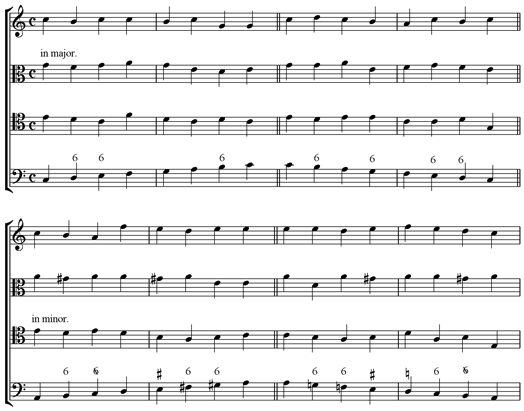
[Ex. A] 2:o) The treble scale

[Ex. A] 3:o). The alto scale.
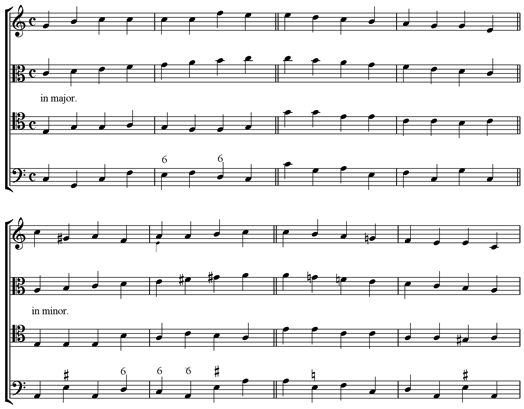
[Ex. A] 4:o). The tenor scale.
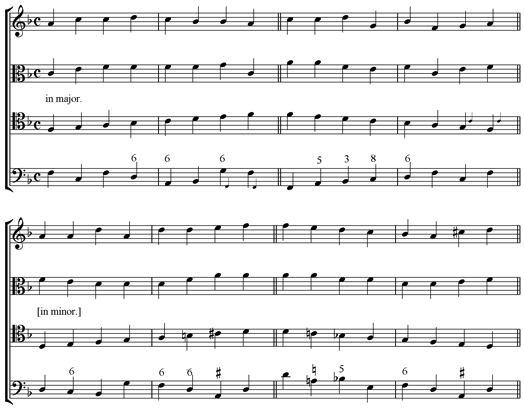
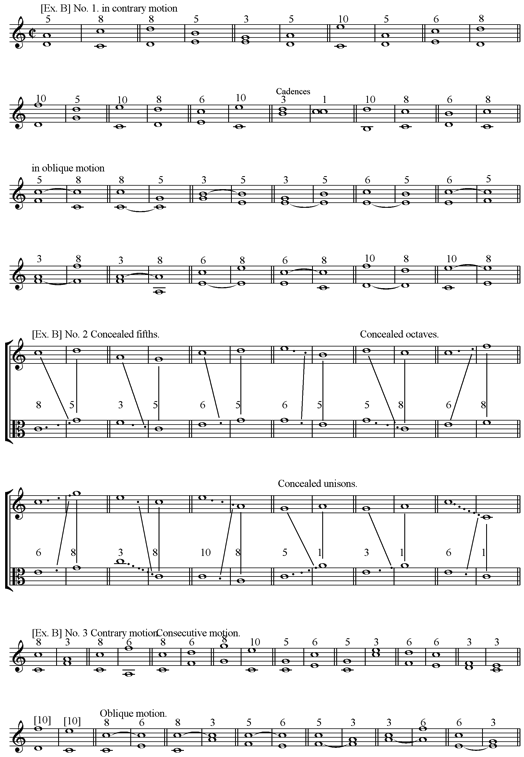
[fol. 4r.]
[8.1] Chapter 1
On composition in two parts
The first species, with note against note, or the same note-value in the principal melody and the contrapuntal part. The rules that apply here are the following:
1). When out of two concords the latter is a perfect consonance, the progression from one to the next should avoid consecutive motion (motus rectus), using instead either contrary or oblique motion; the first concord may be a perfect or imperfect consonance, see Ex. [B] 1 on the opposite page. Otherwise open or concealed fifths, octaves and unisons may result: the former type unacceptable in all composition, the latter particularly so in two-part writing. See some examples under the [Ex. B] number 2.
One can express this principle even more clearly in the following way: an octave, fifth or unison (which are the perfect consonances) may not follow in consecutive motion, whether upon intervals of the same kind, or on a third or sixth (imperfect consonances) preceding it, but must then instead use contrary or oblique motion, whichever of them is necessitated for the effortless progression in the song.
2.) An imperfect consonance (third or sixth), however, may be reached immediately from either a perfect or an imperfect consonance, by all three types of motion. See some examples under [Ex. B] number 3.
3.) The beginning and the end, that is the first and last pair of notes, must make up a perfect consonance (perfect octave, unison or fifth), although not in such a way that one terminates on the fifth in the upper counterpoint, and not set out with the fifth in the lower. However, this principle only applies in instances where the canto fermo begins on the principal scale degree; if it begins on the third, the upper counterpoint must be placed at the sixth and the lower at the lower third; if it starts on the [fol. 4v.] fifth, the lower counterpoint must have the lower fifth, which is the principal scale degree itself; but in instances where the canto fermo is to be the lower part, over which the counterpoint is to appear, the first note must be altered to the principal scale degree itself, and can then become lower fifth to the counterpoint. For example:
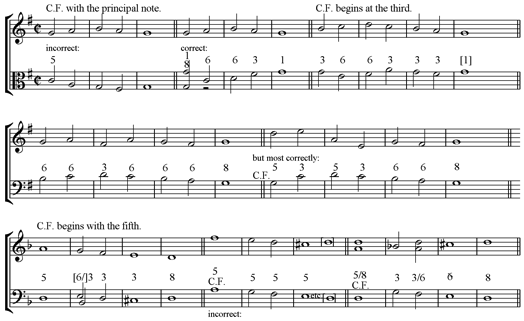
In brief: the rule applies only when the principal melody or canto fermo starts at the principal scale degree, and for counterpoint, particularly in two-part writing, it is also best to choose such a principal melody.
4.) In all bars and on all beats of all bars only consonances may occur, and generally more imperfect (sixths and thirds) than perfect ones (unisons, octaves and fifths). As for the unison, which results in a somewhat hollow concord, one refrains from using it apart from in the first and the final bars.
5.) When the principal part (canto fermo) is the highest, and descends by the interval of a second to the final note at the cadence, the first note in the counterpoint takes a minor third or a minor tenth below it. If the principal melody ascends by a second from the leading [fol. 5r.] note to the keynote, the counterpoint takes a major sixth below it. If, on the other hand, the principal part is set as the lowest, the counterpoint takes a minor third above it if it ascends, but a major sixth above it if it descends. The following example may serve as explanation:

6.) Two major thirds in succession, moving in such a way that each part ascends or descends a major second, are prohibited; so also if both parts ascend or descend by a leap of a major third, since both these cases result in what is called an non-harmonic cross-relation, an impure relationship between the two opposing intervals in succession, which offends the ear and which cannot be used until one has progressed to three-part writing, where the harsh effect is alleviated by the third part. Also in connection with the parts leaping a fifth, two major thirds are prohibited, since such an instance reveals a major seventh in between the parts, a seventh that is difficult to sing both in ascending and descending motion and which has a harsh sound. In connection to the leap of a perfect fourth the aforementioned type of thirds are good and permitted. For example:

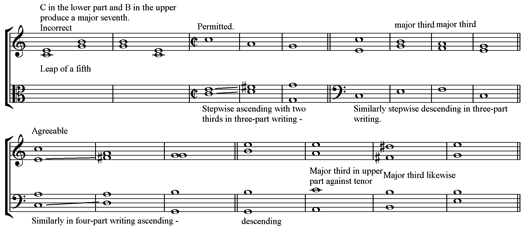
Two major thirds both ascending a major sixth are entirely reprehensible, since through these an insufferable non-harmonic cross-relation would occur; in a leap of two sixths they can be tolerated, and sometimes have a good effect, for example:

7.) Both perfect and imperfect cadences are forbidden within the setting, the latter being forbidden also at the end ([Ex. B] number 4, Lit. A), but in the last two bars the type of imperfect cadence shown in Lit. B occurs.
8.) All augmented and diminished interval progressions are prohibited in counterpoint, as are leaps by the three types of seventh-interval: major, minor and diminished; ascending or descending. The same holds true of leaps of a ninth or tenth – exceptions from this general principle are leaps by the diminished fourth and fifth. The intervals that are thus allowed appear in the example opposite ([B] number 5).
9.) One also avoids, as far as possible, to write more than three thirds or sixths in successive consecutive motion, since this produces a tedious song, resembling folk melodies.
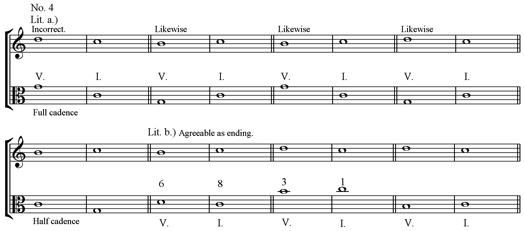




10.) Furthermore, one note should not be prolonged over three bars in two-part writing, not even in alla breve meter (2/2 or ![]() metre), in 2/4, 3/2 nor in 3/4; dwelling longer on the same note would make the singing feeble and monotonous.
metre), in 2/4, 3/2 nor in 3/4; dwelling longer on the same note would make the singing feeble and monotonous.
11.) Harsh and poor singing results also if one proceeds by three or four notes to the major seventh, or to a ninth, in the way shown in example [B] number 6 on the opposite page, for which reasons such passages should be avoided.
12.) All chromatic progressions, that is those by semitones, are prohibited in counterpoint; such as in example number [B] 7; between B and B flat, or A and A flat.
13.) The progressions on the opposite page, Ex. [B] 8, in an upper part proceeding to the octave, when it falls on the accented beat of the bar, or the downward stroke, while the lower part ascends a tone or a semitone, are certainly not acceptable, whether in two-part writing, in strict or free kind, and preferably not in three-part writing either. In three-part writing they could be covered, but even there they have a hideous effect when appearing between outer parts.
[8.2] Two-part writing
Second species, with two or three notes in the counterpoint against one in the canto fermo
1.) The beginning is set with or without a rest, which counts for one beat of the bar. In whichever case, the first note should be a perfect consonance when the principal part starts on the keynote.
2.) In all the remaining bars the accented beat, or the downward stroke, should always have a consonance, be it perfect or imperfect. On the unaccented beat also dissonances may occur, but these should never be reached by leap, but in passing motion, so that they occur in between two notes which either form a third between them, or appear on the same line in the system, that is, producing a unison. See the opposite example [C] number 1.
3.) The cadence is accomplished in the upper counterpoint either with a perfect fifth and a major sixth, or with a minor tenth and major sixth following in succession in the penultimate bar. In the lower counterpoint it is achieved again in the same manner and in the same bar, by a perfect fifth and a minor third, or the tenth. See example [C] 2.
If the canto fermo should ascend a semitone at the cadence, the conformation of the counterpoint is adjusted accordingly [marginal note:] Further explanation follows below.
4.) Two or more fifths, octaves or unisons, falling on the accented beat or the downward stroke of the bars and following in succession with leaps of thirds in between, are just as offensive as the immediate succession of the same intervals in consecutive motion, and therefore are rejected. If they fall on the unaccented beat of the bar, or the upward stroke, they are not considered to be faulty.
If they appear on the downward stroke immediately following a leap of a fourth they are also permitted, and used by good harmonists. See the examples under number [C] 3.
As for the rest, all principles prescribed for the first species of counterpoint are observed, excepting the fourth and fifth ones, which are not applicable here.
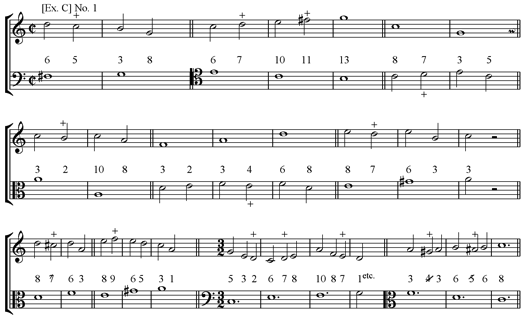

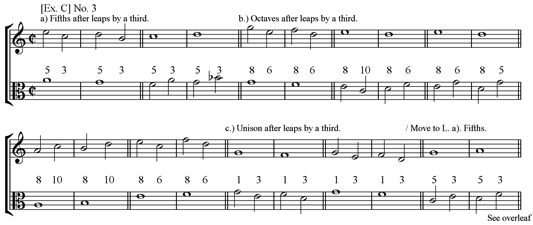
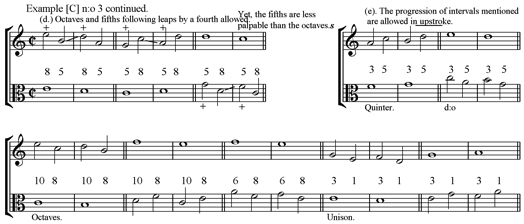
One should nonetheless be cautious, especially in two-part writing, not to produce a lengthy succession of deferred octaves, fifths and unisons, but to set only two or three in succession. The following improvement will result from this, in another manner of writing, e.g.:
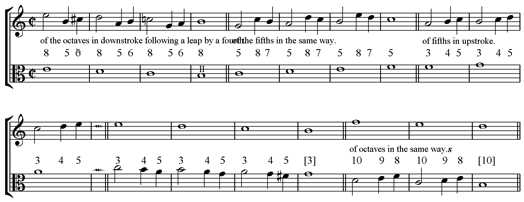
[fol. 9v.] [fol. 9r. is blank, but ruled with staves]
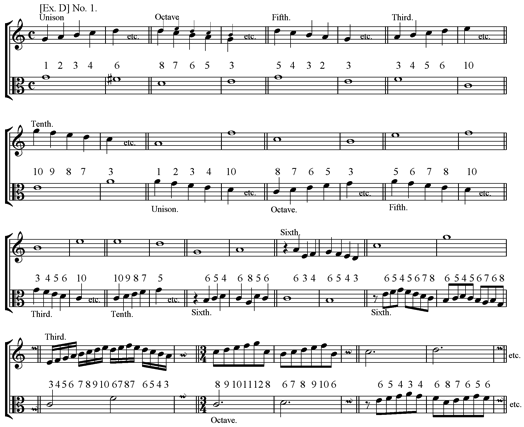

[8.3] Two-part writing
The third species, with four, six or eight notes in the counterpoint, against one in canto fermo
Apart from the rules mentioned in the preceding two species, as far as they still are useful here, the following is observed:
1.) In even as well as in uneven meters the first note should be consonant; here, however, the initial consonance need not necessarily be a perfect one, but may alternatively be a third or tenth. See the examples on the opposite page, at number [D] 1. If the counterpoint starts with a rest, the first note may also be a sixth.
2.) To produce a leap of a third, ascending or descending, after a succession of three or four notes in stepwise motion, violates the property of a good melody, and should therefore be avoided. Larger leaps are moreover rarely agreeable after such a row of notes in stepwise motion. See Ex. number [D] 2.
Agreeable leaps of thirds are:
![]()
The following leap of a fourth is also agreeable, since the harmony in each pair of bars is founded on one common chord.

3.) The sevenths and fourths appearing on the opposite page, which do not resolve but instead either produce a descending leap of a third or proceed one step in ascension, are with support from the example of approved harmonists admissible in this species of counterpoint, in two-part writing, as well as in three- and four-part writing.
4.) When the counterpoint provides the upper part the cadence is given a major sixth at the penultimate note; if it provides the lower part, it is given a minor third or tenth. This applies, however, only in the case of a canto fermo that concludes with the descent of a second. If it concludes with a minor second ascending, the relationship in the counterpoint is reversed. The following may serve as examples of concluding cadences in both types of counterpoint:
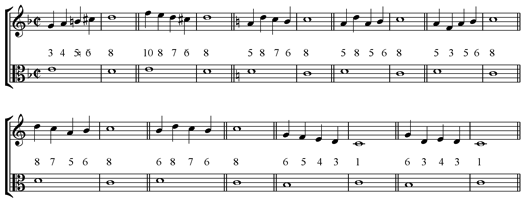
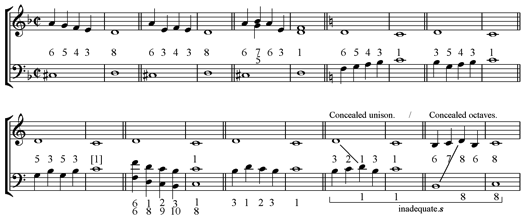
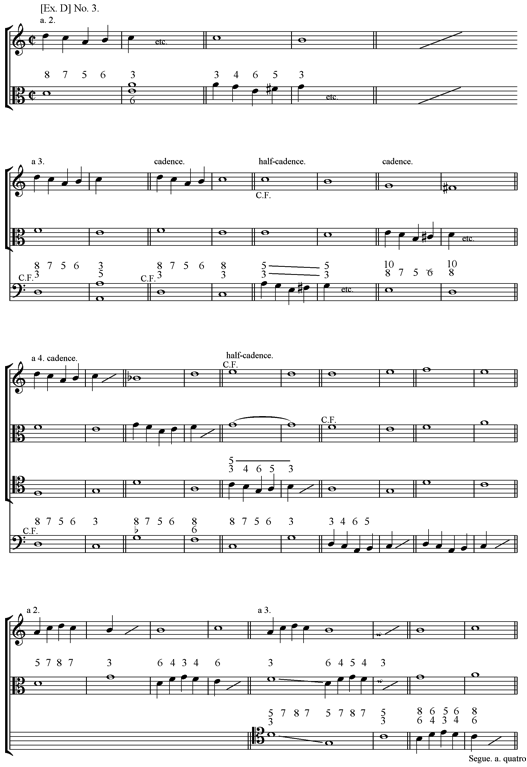
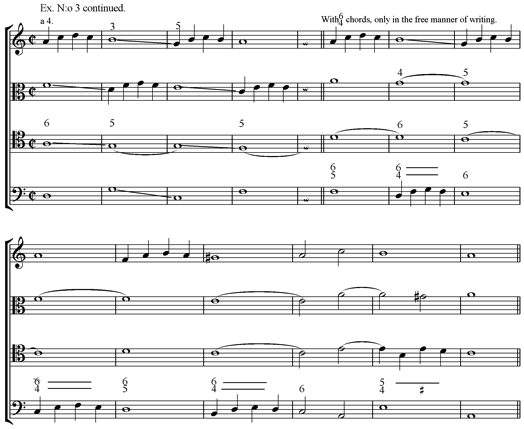
[9]
[Pehr Frigel]
Om Contrapunkten
[Swedish Original]
Med contrapunktera förstår man, att till en gifven hufvud-melodie, sätta en eller flere andre melodier eller stämmor, som tillsammans med den förre utgöra en regelbunden harmonie. Då man antagit en viss sådan hufvud-melodie, som skall contrapunkteras, får den namn av canto fermo, det vill säga, den fastställda eller oföränderliga sången. Den eller de andre stämmorne hvilka man dertill sätter, benämnes med ordet contrapunkt.
Contrapunkten är enkel eller dubbel; det förra, då den sättes, utan att kunna lika passa både under och öfver en hufvud-melodie, och måste förändras som dess öfre eller undre läge sådant fordrar. Dubbel kallas den åter, då den är så inrättad, att, i hvilket läge till hufvud-melodien han sättes, antingen öfver eller under, han efter harmoniens reglor lika väl passar till den samma, men frambringar olika intervall, och således åstadkommer variation med bibehållande af så väl den contrapunkterande melodiens som den hufvud-melodiens enhet.
Man indelar den enkla contrapunkten uti två särskildta hufvudslag, nämligen:
1:) Uti den likartade, (contrapunctum aequale, nota contra notam) där mot hvar not i canto fermo, sättes blott en not.
2:o) Uti den olikartade (contrapunctum inaequale) som har flera noter emot en i hufvud-melodien, och denne åter är af 4. särskildta arter nämln:
a:) En, hvar uti 2 eller 3. noter svara emot en not i canto fermo. [fol. 1v.]
b.) En, där 4, 6 à 8 noter svara emot en uti canto fermo;
c.) En, där bindningar och syncopationer förekomma ; och slutligen,
d.) En, som består af alla de föregående arterne om hvarandra, och tillåter flerahanda melodiska figurer, samt kommer under namn af den blandade eller zirliga contrapunkten (contrapunktem mixtum vel floridum.)
Alla dessa arter af contrapunkt nyttjas olika strängt i den friare eller så kallade galanta sattsen och i den strängare sattsen, hvilken sednare egentligast tillhör kyrko- och choralmusiken, och är igenom reglor vida mera inskränkt, än den förre, hvilken nyttjas till instrumental-compositioner i allmänhet, till musik för operan, till oratorier och cantater, m.m.
Det är nyttigt och oumgängeligt, att först väl öfva sig i den stränga sattsen, innan man går till den friare, på det man må vänja sig att sätta en ren och regelbunden harmonie, och riktigt kunna urskilja och bedöma de undantag från allmänna harmoniska reglorne, som den senare sattsen tillåter och ofta fordrar.
För stränga sattsen, där inga dissonerande intervall få utan förberedning och upplösning förekomma, äro följande ton-scalor fastställde, som visa hvilka intervall där tillåtas, då frågan är att contrapunktera med not mot not; se motstående samt följande 2ne sidor där desse scalor både i dur och moll förekomma, under nummerne [Ex. A] 1, 2, 3, och 4.
[Ex. A] 1:o) Stränga sattsens bas-scala, hvaröfver blott fullkomliga (consonerande triklang) samt små och stora (consonerande) sext-accord tillåtas:
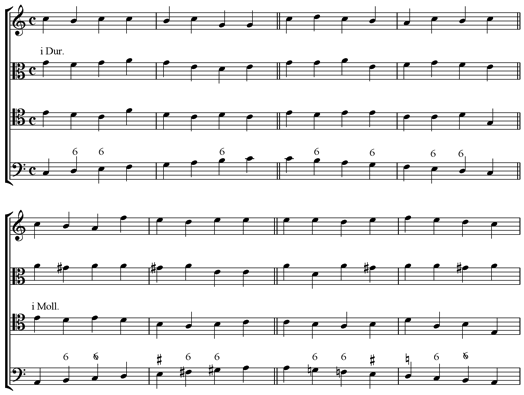
[Ex. A] 2:o) Discant-scalan
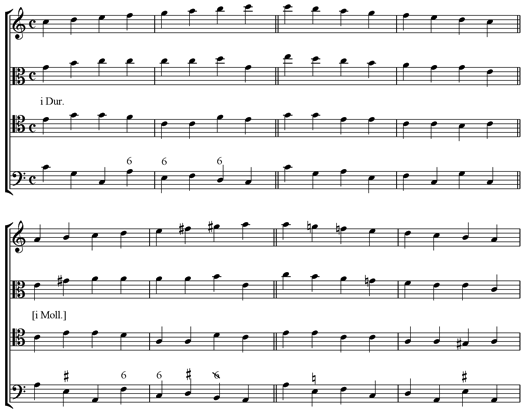
[Ex. A] 3:o). Alt-scalan.
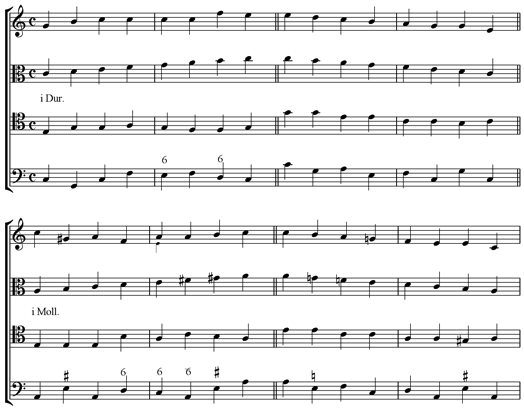
[Ex. A] 4:o). Tenor-scalan.
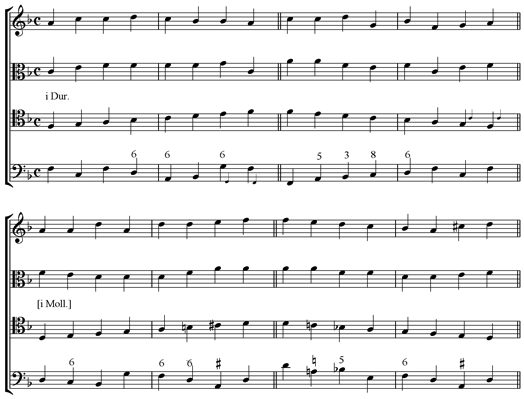
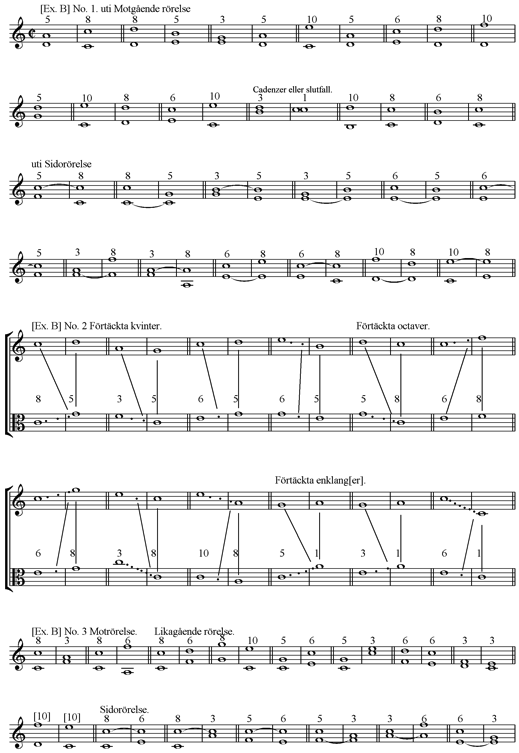
[9.1] 1. Cap.
Om tvåstämmig satts
1sta slaget, med not mot not, eller lika notvalörer i hufvud-melodien och contrapunkterade stämman. Reglorna äro här följande:
1o) Då af två Accord, det sednare utgör en fullkomlig consonant, så bör vid fortskridningen dertill den likagående rörelsen (motus rectus) undvikas och i stället brukas den motgående eller sidorörelsen, det första accordet må vara fullkomligt eller ofullkomligt consonerande, se Ex. [B] no 1. på motstående sida. I annat fall uppkomma uppenbara, eller ock förtäckta quinter, oktaver eller enklang; de förra i all composition, de sednare särdeles i tvåstämmig, förkastlige. Se några prof under [Ex. B] No 2.
Man kan uttrycka denne regeln ännu tydligare på följande sätt: En octav, quint eller enklang, (som äro de fullkomlige consonanter) få ej i den likagående rörelsen omedelbart följa, hvarken på intervall af samma slag, eller på en terz eller sext (ofullkomlige consonanter) som gå näst förut, utan måste då den motgående eller ock sidorörelsen brukas, hvilkendera af dem som sångens lediga gång fordrar.
2o) Deremot kan man till en ofullkomlig consonant (terz eller sext) omedelbart ifrån en vare sig fullkomlig eller ofullkomlig consonant, gå genom alla 3. slags rörelserne – se några exempel under [Ex. B] No 3.
3o) Början och slutet, det vill säga: första och sista paren noter, måste utgöra en fullkomlig consonant, (ren octav, enklang eller quint) dock så, att man i öfre contrapunkten ej får sluta och i den undre ej börja med quinten. Denne regel är likväl gällande allenast i det fall att canto fermo börjar i hufvud-tonen: börjar den åter i terzen, måste öfra contrapunkten få sexten, och den undra under-terzen; börjar den i [fol. 4v.] quinten, så måste undra contrapunkten få under-quinten, som är sjelfva hufvudtonen; men i det fall canto fermo skall blifva understämma, hvaröfver contrapunkteras, måste första noten ändras till sjelfva hufvudton, och kan då blifva under-quint till contrapunkten. Till ex.:
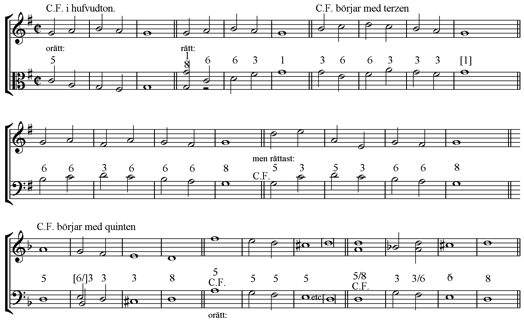
Korrt: regeln gäller blott, när hufvudstämman eller canto fermo börjar med sjelfva hufvudtonen, och till contrapunktering, i synnerhet i tvåstämmiga sattsen, är ock bäst att välja sådan hufvudstämma.
4o) I alla takter och taktdelar förekomma blott consonanter, dock mer ofullkomlige (sexter och terzer), än fullkomlige (enklang, octaver och quinter). Hvad enklangen beträffar, som medför en viss tomhet i sammanstämningen, undflyr man att använda den vidare, än i första och sista takten.
5o) Då hufvudstämman (canto fermo) står öfverst, och vid slut-cadencen faller ett secund-intervall till sista noten, får den första noten uti contrapunkten en liten under-terz eller under-decima; stiger åter hufvudstämman ett secund-intervall från subsemi- [fol. 5r.] tonium till tonican bekommer contrapunkten en stor under-sext; deremot om hufvudstämman försättes nederst, får, vid dess stigande, contrapunkten en liten öfver-terz, men, vid dess fallande, en stor öfver-sext. Följande exempel kan tjäna till förklaring:

6o) Två stora terzer efter hvarandra, då hvardera stämman stiger en hel ton uppåt eller nedåt, äro förbudne; äfvenså om bägge stämmorne göra ett stort terz-språng i stigande eller fallande, ty i bägge fallen uppkommer ett så kalladt oharmoniskt tvärstånd, ett orent förhållande emellan de motstående på hvarandra följande intervallen, som misshagar örat, och ej förr än i trestämmig satts kan brukas, där den elaka effecten betages genom 3dje stämman. Vid stämmornes språng en ren quint är likaledes 2. stora terzer förbudna, emedan i sådant fall en stor septima yppar sig inom bägge stämmorne, hvilken septima alltid så väl i stigande som fallande är svår att sjunga och låter hårdt. Vid ett språng af en ren quart äro deremot nämde terzer gode och tillåtne. Exempel:

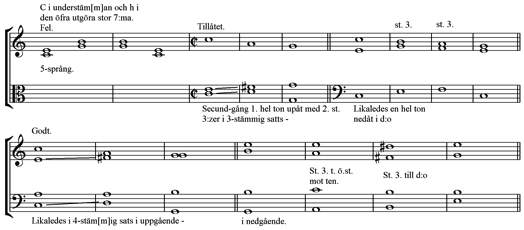
Två stora 3zer bägge stigande en stor sext, aldeles förkastlige, hvarigenom skulle uppkomma ett olideligt oharmoniskt tvärstånd; i ett språng med två sexter kunna de tålas, och göra stundom god verkan: t.e.:

7o) Så väl hela som halfva cadencer äro inuti sattsen, och de förre äfven i slutet, förbudne [Ex. B] (no 4, lit. a), men i de två sista takterne sker den slags half-cadence som lit. b). utvisar.
8o) Alla öfvermåttiga och undermåttiga intervallgångar i contrapunkten äro förbudna, äfvensom sprången med de 3. slags septimorne, stora, lilla och undermåttiga, och detta såväl upp- som nedgående. Likaledes nona- och decima-språng – härifrån undantagas undermåttiga quinten och quarten. De således tillåtna intervall förekomma i motstående exempel [B] No 5.
9o) Man undviker äfven, så vidt sig göra låter att sätta flera än 3. terzer eller sexter efter hvarandra uti jemnlika rörelsen, hvilket åstadkommer en platt sång och liknar vis-melodier.
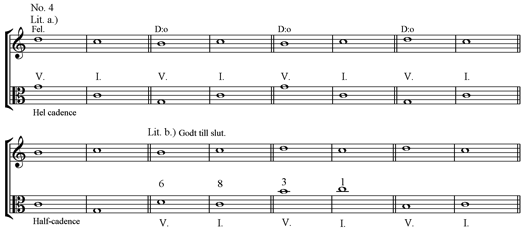



x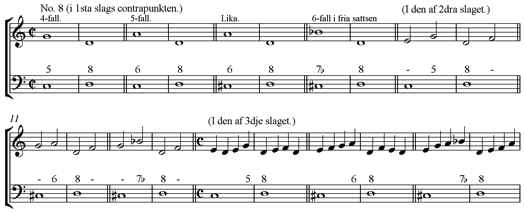
10o) Äfven bör uti 2-stämmiga sattsen en och samma not uti contrapunkten icke fortfara öfver tre takter, om det äfven vore uti alla breve-takt (2/2 eller ![]() takt) den af 2/4 delar, af 3/2 delar eller 3/4 delar, längre dröjande på samma ton skulle göra sången matt och entonig.
takt) den af 2/4 delar, af 3/2 delar eller 3/4 delar, längre dröjande på samma ton skulle göra sången matt och entonig.
11o) En både hård och dålig sång uppkommer åter, om man med 3 eller 4 noter fortskrider till stora septiman, eller till en nona, på sätt motstående exempel [B] no 6. utvisar, hvarföre sådana gångar böra undvikas.
12o) Alla chromatiska fortskridningar, det vill säga med små halvtoner, äro förbudne; som t. e. uti [Ex. B] no 7; emellan H och B, samt A och Ass uti contrapunkten.
13o) De på motstående sida, ex. [B] no 8. förekommande gångar i en öfverstämma till octava, då den faller på den vigtiga taktdelen, eller på nederslaget, vid det understämman stiger en hel eller halv ton, tillåtas alldeles icke i den tvåstämmiga, antingen stränga eller fria sattsen, ej heller gerna i den trestämmiga. I flerstämmig satts kunna de betäckas, men göra äfven där elak verkan, då de förekomma emellan de yttersta stämmorne.
[9.2] Tvåstämmiga satsen
2dra slaget, med 2 à 3. noter i contrapunkten, mot en i canto fermo
1o) Början sker med eller utan paus, som gäller en takt-del. I bägge fallen bör första noten vara en fullkomlig konsonant, då hufvudstämman börjar i tonikan.
2o) I de öfvriga takterna bör den vigtiga delen eller nederstråket alltid få en consonant, den må vara fullkomlig eller ofullkomlig. I den ovigtiga taktdelen kan äfven komma dissonanter, men ej språngvis, utan genomgående, sålunda, att de stå emellan 2ne noter, som antingen sins emellan utgöra ett terzintervall, eller ock stå på samma grad i notplanen, det vill säga utgöra enklang. Se motstående exempel [C] no 1.
3o) Cadencen göres i öfra contrapunkten med rena quinten och stora sexten, eller ock lilla deciman och stora sexten efter hvarandra i takten näst före den sista; i undra contrapunkten åter på samma sätt och i samma takt, med rena quinten och lilla terzen, eller ock deciman. Se exemplet [C] no 2.
Skulle åter canto fermo vid cadencen stiga en half ton uppåt, ändras contrapunctens förhållande derefter [marginal note:] Härom närmare förklaring framdeles.
4o) Två och flera quinter, octaver eller enklang, som följa hvarandra efter mellankommande terzsprång, och falla på den vigtiga taktdelen eller nedstråket, äro lika vidriga, som samma intervallers immediata följd i den jemnlika rörelsen, och förkastas derför. Falla de åter på den ovigtiga taktdelen eller uppstråket, anses de ej felaktiga.
Äfvenledes om de förekomma på nedstråket efter ett quartsprång, gillas de och brukas af goda harmonister. Se exemplen [C] no 3.
I öfrigt iakttagas alla de för 1sta contrapunkterings-arten föreskrifne reglor, utom den 4de och 5te såsom hit ej lämplige.
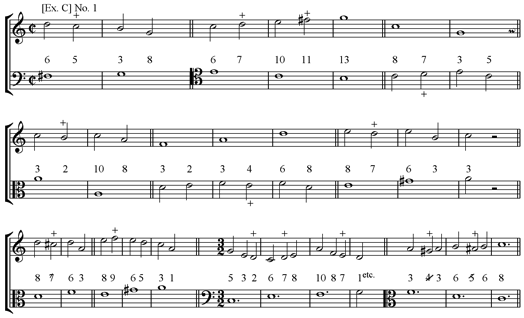

x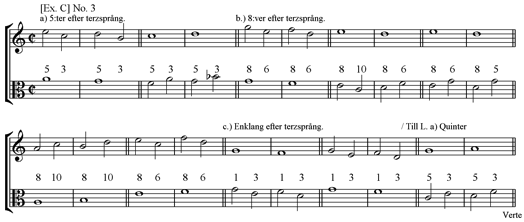
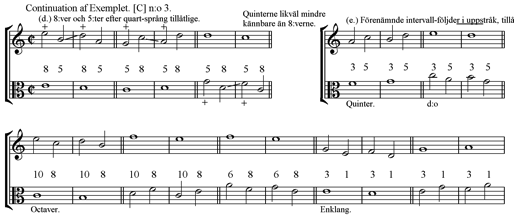
Likväl bör man bruka den varsamheten, i synnerhet i 2-stämmiga sattsen, att ej göra en längre följd af sådana efterslående octaver, quinter och enklang, utan högst 2 à 3 efter hvarandra. Följande förbättring häraf äger rum, uti en annan genre af satts – till ex.:
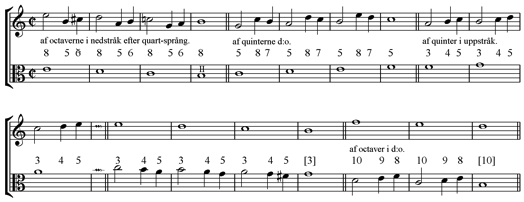
[fol. 9v.] [fol. 9r. is blank, but ruled with staves]
x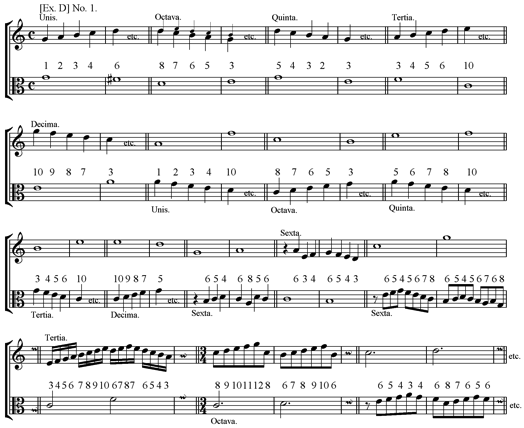

[9.3] Tvåstämmiga satsen
3dje slaget, med 4, 6 eller 8. noter i contrapunkten, emot en i canto fermo.
Utom de i föregående 2nne slags contrapunkter omnämde reglor, så vidt de här äro användbara, iakttagas följande:
1o) Såväl i jämna, som ojämna takterne, bör första noten vara en consonant, dock ej här nödvändigt fullkomlig, utan kan äfven vara en terz eller decima. Se exemplen på motstående sida [D] no 1. Om contrapunkten börjas med en paus, kan ock första noten vara en sext.
2o) Att göra ett terzsprång uppåt eller nedåt efter 4 eller 3. gradvis på hvarandra följande noter, strider emot egenskapen af en god melodie, och bör derför undvikas. Större språng äro ock sällan gode efter dylike gradvis gående noter, se ex: [D] no 2.
Goda terzsprång äro:
![]()
Följande quartsprång är äfven godt, då harmonien i bägge takterne grundar sig på ett och samma accord:

3o) De på motstående sida, no 3. förekommande septimor och quarter, som ej resolvera, utan antingen göra ett terzsprång nedåt, eller gå en grad uppåt, äro i stöd av godkände harmonisters exempel, i detta slag af contrapunkt, tillåtlige såväl i 2-stämmig, som i den 3- och 4-stämmige sattsen.
4o) Då contrapunkten är öfverstämma får cadencen en stor sext näst före sista noten; är han åter understämma, en liten terz eller decima. Detta gäller dock blott vid en canto fermo som slutar med en sekundgång nedåt. Slutar den med en liten sekundgång uppåt blir förhållandet i contrapunkten tvärtom. Följande må tjena till exempel af slut-cadencer i bägge contrapunkterne:
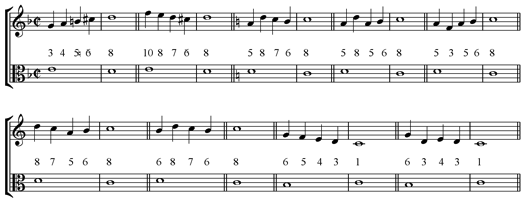
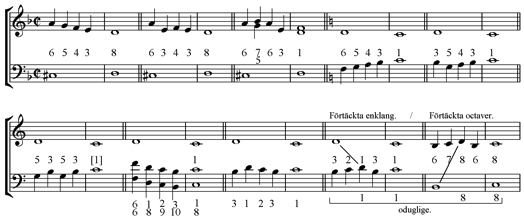
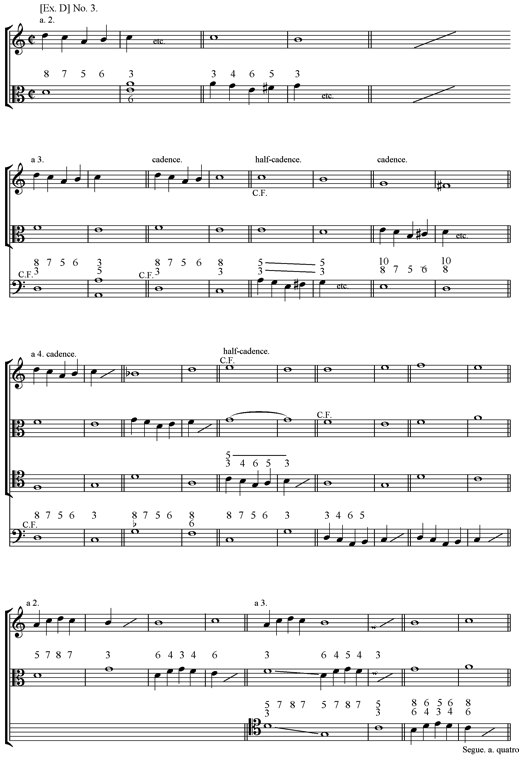
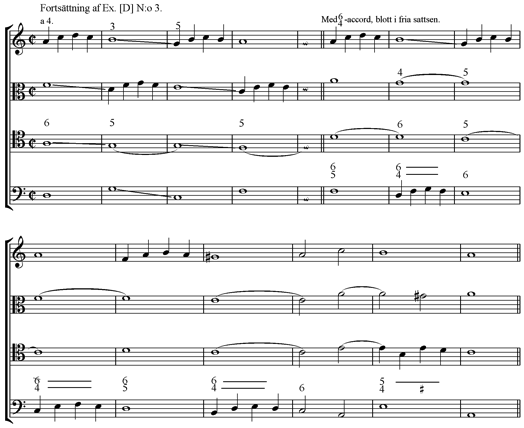
[10] Commentary
consonerande triklang ] The Latinate spelling ”triklang” gave place in later Swedish usage to “treklang”.
1sta slaget, med not mot not
enklang ] Frigel treats this Swedish coinage for unison as singular throughout, even when it comes into a conflict of numerus with a qualifying adjective, such as in Ex. [B] 2: “förtäckta enklang”.
[Ex. B, examples ] Cf. Albrechtsberger (1790), p. 19–22. Unlike Albrechtsberger, Frigel shows only concealed consecutives, seemingly viewing the more obvious instances as being clear from the rules stated above. Frigel also demonstrates all the notes traversed in concealed consecutive motion, see below [Ex. B] N:o 2: “Förtäckta…”.
[Ex. B] No. 1, uti Motgående rörelse ] the eighth progression under this heading has c'' – g'' in the upper part, thus conflicting with the first superscript interval number (“10”). Since no other example with a twelfth is given, the note has been adapted to the interval number.
[Ex. B] No. 1, uti Motgående rörelse / Cadenzer eller slutfall ] One reason for listing the three cadential types allowed in first species counterpoint in two parts under a separate heading is the notion that the second of them (10 – 8) is allowed only as a cadential form, prohibited on weak beats as an octava battuta, something that Frigel, in accordance with Fux, points out for example in his Haeffner annotations.[29] See below.
[Ex. B] No. 1, uti Sidorörelse ] the first progression under this heading has a' – c' in the lower part, thus conflicting with the first superscript interval number (“5”). Since the descending major sixth is explicitly prohibited in the treatise, the note has been adapted to the interval number.
[Ex. B] No. 2, Förtäckta … ] Concealed, or covered, consecutive motion is illustrated by pointing out the scalar motion that lies between the two intervals, thus also presenting the rationale for their prohibition (the motion is not merely outlined by dotted lines, but by the scalar steps theoretically traversed). This links up with rules for passaggiato writing and foreshadows regulation of the third species of counterpoint while still relating to the preceding scalar exercises. It is likely that Frigel drew this general idea from Gradus ad Parnassum.[30] In the fifth example of concealed consecutive octaves (10 – 8 descending), the line interconnects c (lower part) with c' (upper part), rather than b and b'. This has been altered to conform with the other examples.
[Ex. B] No. 3 …Sidorörelse. ] Tie is missing in the last example (6 – 3).
…kunna tjena till förklaring: ] In the first example (6 – 3 –1), the interval number of the second note in the lowest part is crossed out.
stiger en hel ton uppåt eller nedåt ] Frigel uses “stiger” (‘ascends’) as progressing stepwise in both directions, not according to present usage (where it denotes ascending motion only).
Alla öfvermåttiga och undermåttiga intervallgångar ] Only one of these terms, derived from “über-” and “untermässig” were to stay (in altered form) in Swedish usage, in present usage: “överstigande”. “Undermåttig” is seemingly not to be found in literature after Frigel. Moreover, both the terms in present usage were in use before Frigel’s treatise, e.g. in Miklin.[31] Envallsson gives “öfverstigande” as a general term, but “uphöjd” when used specifically for bass notes.[32]
[Ex. B] No. 4 ] cf. Albrechtsberger (1790, p. 22), with additions by Frigel. Frigel also adds function numberings (as in basse fondamentale) giving both these and Albrechtsberger’s interval numbers for the last examples.
[Ex. B] No. 5. ] Here, as in the preceding example illustrating consecutive thirds progressing by leap of a minor sixth, Frigel uses the direct sign (![]() ) to indicate voice-leading suggestions after leaps. In the example of an ascending diminished fifth in No. 5 he leaves the alternatives of countering the leap either with b natural or b flat. In the last example with the descending minor seventh, he has first inscribed the direct on a, that is an ascending step from the second note. In layer B he has crossed this out and placed the direct on e, just as in the preceding example, suggesting, rather unusually, a dominant function where f is prolonged and resolved to the third in a C major chord.
) to indicate voice-leading suggestions after leaps. In the example of an ascending diminished fifth in No. 5 he leaves the alternatives of countering the leap either with b natural or b flat. In the last example with the descending minor seventh, he has first inscribed the direct on a, that is an ascending step from the second note. In layer B he has crossed this out and placed the direct on e, just as in the preceding example, suggesting, rather unusually, a dominant function where f is prolonged and resolved to the third in a C major chord.
genomgående … antingen sins emellan utgöra ett terzintervall, eller ock stå på samma grad i notplanen, det vill säga utgöra enklang. ] From this passage, it seems that Frigel also subsumes neighbouring notes under the category of passing notes in linear progressions.
[Ex. B] No. 8 ] cf. Albrechtsberger (1790, p. 28–29), where it is stated that the examples with 7b – 8 progressions are only allowed in the free manner of writing. This example anticipates the chapters on the second and third species, seemingly in order to illustrate how the second species can be seen as a diminution of the first. The example in third species, however, deviates from the substructure of the other preceding examples.
2dra slaget, med 2 à 3. noter i contrapunkten, mot en i canto fermo
[Ex. C] No. 1 ] The first example is taken from Albrechtsberger (1790, p. 35), the second is Frigel’s own, illustrating and stressing somewhat different points than Albrechtsberger.
[Ex. C] No. 2 ] Cf. Albrechtsberger (1790, p. 36–37), the third and fourth examples being transposed versions. In the third example (5–3–1), the second interval number has been crossed out and altered from “10” to “3”.
[Ex. C] No. 3 ] Cf. Albrechtsberger (1790, p. 37), the examples having been reordered typologically, so that all fifths come first, then octaves, and finally unisons. The third example under c.) are, according to Frigel’s annotation, to be moved to a.). It is methodologically redundant, since it raises the same point already illustrated in the second example under a.).
nedstråk … uppstråk ] “Nedstråk” is a cognate of “Niederstreich” and “downstroke”, but has in later Swedish usage come to signify exclusively a downbow for bowed instruments. It has here been rendered “downward stroke” throughout, since Frigel clearly refers to tactus, the downward stroke of the conductor’s hand, in turn derived from “θεσις” in prosody and music.[33]
af octaverne i nedstråk ] Layer A has “quinterne”, later crossed out and corrected.
förtäckta ] According to Albrechtsberger all these progressions constitute ottava battuta (“Streich-Octave”), defined there as a progression “von einem schlechten Tachtteile auf einen guten in der Oberstimme, durch einen Quarten, Quinten, oder Sexten-Sprung herab in die reine Octave gesprungen wird, und die Unterstimme nur um einen halben oder ganzen Ton in der gegen-Bewegung hinauf geht”.[34] This deviates from how the same term is understood by Fux, who clearly reserves the term only for 10 – 8 progressions (2 – 1 progressions are also left out of the definition): “progressus es [sic] de decima in octavam conjunctis partibus, id est, parte inferiori ascendendo, et parte superiori descendendo gradatim se movente”.[35] Elsewhere (in the Haeffner annotations) the occurrence of 10 – 8 progressions in contrary motion to a strong beat is a central concern for Frigel – unlike Fux who claims that it is of little importance (“parum enim interest”) – always referring to them as octava battuta. Frigel had studied Gradus ad Parnassum already in the 1770s, twenty years before the publication of Gründliche Anweisung. His following Fux rather than Albrechtsberger in this terminology is confirmed by the fact that he does not refer to the concept in relation to Albrechtsberger’s examples, despite the devotion of an entire paragraph in the Gründliche Anweisung to an explication of its own definition (Frigel does nonetheless refer also to Albrechtsberger’s passage in his Envallsson annotations).[36]
3dje slaget, med 4, 6 eller 8. noter i contrapunkten, emot en i canto fermo
[Ex. D, examples ] Cf. Albrechtsberger (1790, p. 43–44 and 48–51). Again, Frigel has reordered all borrowed examples according to the typology of which interval is involved.
[Ex. D] No. 1. ] In the third example, the same upper solution as in the preceding example (following the lower solution in parallel thirds) has been entered, but crossed out before the addition of the interval numbers.
[Ex. D] No. 3. ] In the first four-part example the alto part erroneously has a tenor clef in source. The interval numbers in the last example of the second portion in three-parts have revisions where the crossed out numbers in layer A are no longer legible.
[Ex. D] No. 3. blott i fria sattsen ] It is indeed true that this manner of writing – especially figures such as that found in the soprano in measure 5, outlining an augmented interval – would not be permissible in strict counterpoint. The same holds true, however, also in the case of the example preceding it, where Frigel’s direct sign indicates the descending skip f – B in the bass part.
Bibliography
Ahlbeck, Bengt 1994: Musikutbildning och examination vid Kungl. Musikaliska akademien under “Pehr Frigel-epoken”, 1796-1842, Licentiate thesis, Mitthögskolan, Härnösand.
Albrechtsberger, Johann Georg 1790: Gründliche Anweisung zur Composition, Leipzig: Breitkopf.
von Beskow, Bernhard 1843: Minnesteckning vid Sekreteraren Herr Pehr Frigels Jordfästning, Stockholm: Nordstedt
d’Alembert, Jean le Rond 1752: Élémens de musique théorique et pratique, suivant les principes de M Rameau, Paris: David.
Campion, François 1716: Traite d’Accompagnement et de Composition, selon la regle des octaves de musique, Paris: Adam.
Catel, Charles-Simon 1802: Traité d’harmonie, Paris: Imprimerie du Conservatoire.
Christensen, Thomas 1992: ‘The Regle de l’Octave in Thorough-Bass Theory and Practice, Acta Musicologica LXIV/2, pp. 91–117.
Churchill, William Algernon 1935: Watermarks in Paper in Holland, England, France etc. in the XVII and XVIII Centuries and their Interconnections, Amsterdam: Hetzberger.
Dahlhaus, Carl 1989: ‘Die Musiktheorie im 18. und 19. Jahrhundert’, Geschichte der Musiktheorie ed. Ruth Müller, vol. II: ‘Deutschland’, Darmstadt: Wissenschaftliche Buchgesellschaft.
Enselein, Thomas 2008: Der Kontrapunkt im Instrumentalwerk von Joseph Haydn, Cologne: Dohr.
Frigelius [Frigel], Petrus [respondent pro gradu] 1776: Observationes philologicae in praefationem Lucae evangelii Diss. Uppsala university, Edman. Praeses: Johan Floderus.
Frigelius [Frigel], Petrus [respondent pro exercitio] 1775: Dissertatio physica, sistens observationes quasdam circa motus corporum ex percussione Diss. Uppsala university, Edman. Praeses: Samuel Duraeus.
Fux, Johann Joseph 1725: Gradus ad Parnassum, Vienna.
Grandjean, Wolfgang 2006: Mozart als Theoretiker der Harmonielehre, Hildesheim: Olms.
Greek-English Lexicon 1996, Ninth edn., ed. Henry George Liddell and Robert Scott, Oxford University Press.
Heawood, Edward 1950: Watermarks, Mainly of the 17th and 18th Centuries, Monumenta chartae papyriceae historiam illustratum I, Hilversum: The Paper Publications Society.
Kellner, David 1739: Trogen underrättelse i generalbasen [Treulicher Unterricht im Generalbass Hamburg, 1737, transl. Jonas Lindé], Stockholm.
Kirnberger, Johann Philipp 1771–1779: Die Kunst des reinen Satzes in der Musik I–IV, Berlin.
Koch, Heinrich Christoph 1782–1793: Versuch einer Anleitung zur Composition, Leipzig: Böhme.
Larsson, Gunnar 1971: “Pehr Frigels tankar år 1796 om Musikaliska Akademien och dess ‘offentliga informationsinrättning”’, Svenska musikperspektiv, ed. G. Hilleström, Stockholm: Nordiska musikförlaget, pp. 42–59.
Lester, Joel 1992: Compositional Theory in the Eighteenth Century, Harvard Univ. Press.
Lundberg, Mattias 2010: “The First Hundred Years of Music Librarianship at the Swedish Royal Academy of Music: 1771-1871”, Fontes artis musicae LVII/3, pp. 236–249.
Marpurg, Friedrich Wilhelm 1753–1754: Abhandlung von der Fuge nach den Grundsätzen und Exempeln der besten deutschen und ausländischen Meister, Berlin.
Mecklin, Johan Adolf 1802: För begynnare i tonkonsten: med tabell innehållande skalorne, Linköping: Groth.
Miklin, Johan 1782: Kort begrep om general-bassen [transl. of Marpurg passages], Stockholm: Stolpe.
Noters utseende och tids längd [very brief music primer in Swedish] Sävström, 1777.
Sala, Nicola 1794: Regole del contrappunto pratico, Naples: Stamperia Reale.
Vogler, Georg Joseph 1794: Inledning til harmoniens kännedom, Stockholm: Jacobsson Nordström.
Walin, Stig 1933: ’Den musikteoretiska undervisningen i Sverige under romantiken’, Svensk tidskrift för musikforskning XV, pp. 84–137.
Walther, Johann Gottfried 1732: Musikalisches Lexikon oder musikalische Bibliothek, Leipzig.
Archival material
Alphabetisk förtekning öfver ledamöterne af sällskapet Utile dulci, Uppsala University library (S-Uu), U-169k.
Cronhamn, Johan Peter: [Levnadsteckningar över avlidna ledamöter], Music and Theatre Library of Sweden (S-Skma), Appendix to the Minutes of the Royal Academy of Music, 18/5, 1866.
Frigel, Pehr: [Annotations, in Haeffner, Johann Christian Friedrich: Choral-Bok (Stockholm: Dalén, 1808), c. 1810] Music and Theatre Library of Sweden (S-Skma), Hdsk.
Frigel, Pehr: [Dictamen ad protocollem, concerning the conservatoire of the Royal Academy], Music and Theatre Library of Sweden (S-Skma), Appendix to the Minutes of the Royal Academy of Music, 21/12, 1796.
Frigel, Pehr: [Manuscript for a public lecture on music theory and aesthetics, dated 11/3 1816] Music and Theatre Library of Sweden (S-Skma), Royal Academy of Music Archive, AI a:4.
Frigel, Pehr: [Report concerning the composition teaching at the Royal Academy of Music, 17/12 1814), Music and Theatre Library of Sweden (S-Skma), Royal Academy of Music Archive, AI a:4.
Frigel, Pehr: [Autobiographical sketch], Music and Theatre Library of Sweden (S-Skma), Lovén.
Frigel, Pehr: [Chorale settings and preludes], Music and Theatre Library of Sweden (S-Skma), Z/Sv.
Frigel, Pehr: [Annotations, in Envallsson, Carl: Svenskt musikaliskt lexikon (Stockholm: Marquart, 1802), c. 1802], Music and Theatre Library of Sweden (S-Skma), Litt-Rar.
Roman, Johan Helmich [transl. of Gasparini, Francesco: L'armonico pratico al cimbalo (1708)], Music and Theatre Library of Sweden (S-Skma), Ro: 101.
Notes
[1] This concept is generally taken to denote tonal music submitted to a broad array of interrelated systems of voice-leading regulation.
[2] See Enselein, 2008, pp. 15–28; and Grandjean, 2006, pp. 22–32 and 37–52. For studies that do not focus primarily on individual composers see Dahlhaus 1989, pp. 66–67; and Lester, 1992, pp. 31–35 and 186–189.
[3] It must be emphasized that we discuss here a tension between methods of instruction, not necessarily one between different musical conceptions, such as those often unduly ascribed by some twentieth-century scholars to, for example, species methodology, Generalbass and basse fondamentale theory, respectively.
[4] Apart from a number of short polyglot primers from the sixteenth and seventeenth centuries, the only extant vernacular treatises of music theory prior to 1800 seem to be Vogler (1794), Miklin (1782) alongside Johann Helmich Roman’s translation of Gasparini’s L'armonico pratico al cimbalo (1708) and the translation of David Kellner’s Treulicher Unterricht im Generalbass (1739). Regarding Miklin and the Kellner translation Frigel held that “not much wisdom can be gained from these” (“af dem hämtas ej mycken wisdom”: Frigel, 1796).
[5] The author hereby expresses his gratitude to Dr. Erika Supria Honisch for valuable comments and discussions concerning the translation.
[6] See Dictamen ad protocollem, 21/12 1796.
[7] Academy records of 21/12 1796: “… blefve det ock en anledning för dem, som hafva genie och kallelse till composition, att vinna insigt uti och beflita sig om den rena sattsen”. (“…it would also be a reason for those who possess genius and are called to be composers, to gain insight in the correct manner of writing.”).
[8] For an overview, see Walin, 1933. A more detailed discussion will appear in the forthcoming Ph.D. thesis by Anne Reese, University of Uppsala (expected 2013).
[9] Previously most likely stored in Kalmar stiftsbibliotek (S-SK) these autographs are presently held by the Music and Theatre Library of Sweden (S-Skma), Z/Sv.
[10] Uppsala university library (S-Uu), U 169k. Signed in by his own hand under “corno”. The index, however, lists him erroneously as “Olof Björkman”.
[11] He defended the dissertations Dissertatio physica, sistens observationes quasdam circa motus corporum ex percussione pro exercitio in 1775 (with Samuel Duraeus as praeses) and Observationes philologicae in praefationem Lucae evangelii pro gradu in 1776 (with Johan Floderus as praeses).
[13] S-Skma Litt.Rar. See also Lundberg, 2010.
[15] This explains the extraordinarily rich eighteenth- and early nineteenth-century autograph holdings of the Music and Theatre Library of Sweden, where the Academy collections are presently kept. Already in 1796 Frigel wrote: “Det wore dessutom än mera till ändamålet bidragande om Academien både för råd och underrättelsers skull öpnade correspondence med någre utmärkte och hederlige utländske musici, såsom en Naumann i Dresden, en Albrechtsberger i Wien m.fl. whilka jag tror icke skulle undandraga sig denna lilla möda, då det alltid wore en heder att wara i correspondence med en corps som, mån om sin egen acktning, genom en klok werksamhet förtjente den”. (’It would furthermore be even more beneficial to the purpose if the Academy, both for advice and for exchange of information, entered into correspondence with some distinguished and honourable musici such as a Naumann in Dresden and an Albrechtsberger in Vienna, etc., which I do not think would diminish this small labour, considering that it is always an honour to be in correspondence with a society that, eager to keep its own reverence, deserves the same by way of its sensible dealings”. (Frigel, 1796). Here, he also suggests that the Academy as soon as possible should have a counterpoint treatise printed “at least covering simple [that is, not invertible] counterpoint”.
[16] At his death by the age of 92, he had been active as professor in music theory, academy librarian and secretary for more than 40 years. Erik Drake (1788–1870) had gradually become his successor as professor and librarian since the 1820s and succeeded him later also as Secretary.
[17] von Beskow, 1842, p. 8.
[18] “[Music] blef för honom af böjelse och plikt ett föremål för allvarligt studium. Så omfattande, djup och säker kännedom av musikens lagar har kanske knappast någon inom fäderneslandet ägt.” (Beskow, 1843). “Frigel var en lärd musiker, en grundlig kontrapunktist, ock värderades såsom sådan af Europas ypperste mästare i tonkonsten.” (Cronhamn, 1866).
[19] Royal Academy of Music Archives, AI: a4.
[20] The manuscript for a public lecture on music theory and aesthetics (1816) provides valuable suggestions as to what Frigel regarded as the foundations of musical learning. Counterpoint and harmony belong to different classes in his typology. The “musical syntax” presupposes a full knowledge of correct harmony and which type of voice-leading can be achieved “within the circuit of each scale” (implying regle de l’octave teaching, see below). 1816, fol. [5v.]. “Musical grammar” is subdivided into “semiography” (knowledge of the graphemic system of music,) harmony and “rhythmopoeitics”.
[21] See Christensen, 1992.
[22] Traité d’Accompagnement et de Composition, selon la règle des octaves de musique (Paris: Adam, 1716). Many later methods which Frigel had studied and annotated commence with such exercises, e.g. Kirnberger’s influential Die Kunst des reinen Satzes in der Musik I–IV (Berlin, 1771–79) and also, within Sweden, Miklin (1782, p. [11]).
[24] Traité d’harmonie (Paris: Imprimerie du Conservatoire, 1802).
[25] He saw, through Johann Heinrich Küster, to the purchase of Nicola Sala’s Regole del contrappunto pratico (Naples: Stamperia Reale, 1794), for a considerable sum in 1815. In his Dictamen ad protocollem he mentions the Venetian and Neapolitan conservatoires, only in relation to vocal training (Frigel, 1796).
[26] Future research could also look examine the points relating to previous species counterpoint which are particularly stressed in Om Contrapunkten, in the light of Frigel’s own considerable output as a composer. Suffice it to say here, that he was regarded (and regarded himself) a conservative composer as regards matters of technical detail.
[27] S-Skma, Hdskr. 21.
[28] None of the examples of genuine and copied Honig paper watermarks given as examples in Churchill (1935, pp. [73, CLV–CLX, numbers 179–185] or Heawood (1950, see list to plates on p. 48) match this watermark.
[29] Frigel, c. 1810.
[30] Fux, 1725, pp. 49–50: “Vides ergo, quomodo diminuendo quintae saltum, duae quintae, quarum una antè per diminutionem abscondita erat, patefiant.”
[31] Miklin, 1782: “öfverstigande” (p. [7]) and ”förminskad” (p. [8]).
[32] Envallsson, 1802.
[33] s.v. “θεσις” in Liddell and Scott, 1996.
[34] Albrechtsberger, 1790, p. 28.
[35] Fux, 1725, p. 53.
[36] Frigel, c. 1802, p. 229. Frigel finds many faults with the dictionary and has entered a number of terms which he regards as missing, many of them pertaining to counterpoint.
